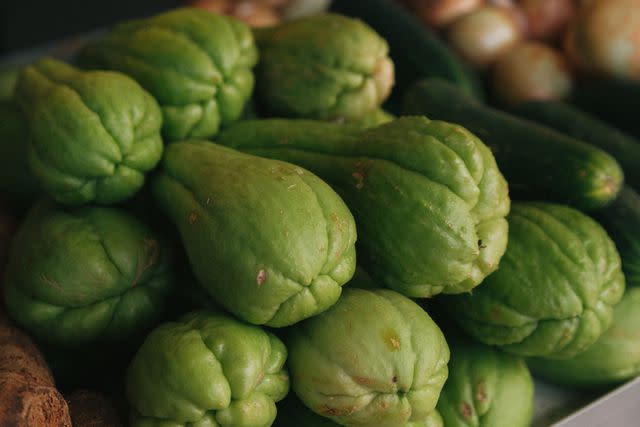Health Benefits of Chayote
Dense With Fiber, Antioxidants, and Flavonoids
Medically reviewed by Jonathan Purtell, RDN
Chayote squash is eaten like a vegetable but is technically a fruit due to its large seed in the center. A member of the squash and cucumber family, chayote squash has a mild, crunchy flavor when raw, and it's similar to zucchini when cooked.
Chayote likely originated in Mexico, where it was popular among the ancient Aztecs. European explorers took it to Europe, and it also spread throughout the Americas and Asia. Despite its global popularity, it's not a widely used vegetable in the United States.
Chayote goes by many other names. The French call it "christophine" (after explorer Christopher Columbus). In parts of the American South, it's often called "vegetable pear" or "alligator pear," while in Cajun cooking it's known as "mirliton." In the Caribbean, it goes by "chocho." In India, it’s called "chow chow."
This article will look into chayote squash's health benefits.

Wirestock / Getty Images
Mexican Chayote Nutrition Facts and Compounds
According to the U.S. Department of Agriculture (USDA), 100 grams (about three-fourths cup) of cooked and drained chayote contains:
Protein: 0.82 grams (g)
Carbohydrates: 4.51 g
Fiber: 1.7 g
Calcium: 17 milligrams (mg)
Magnesium: 12 mg
Phosphorus: 18 mg
Potassium: 125 mg
Chayote also contains several antioxidants, which prevent cell damage and have anticancer and anti-inflammatory properties, as well as protecting brain and heart health. These include flavonoids and polyphenols.
Chayote is low in calories and fat, with only 19 calories and less than 0.15 grams of fat per 100 g serving.
Chayote Benefits
Chayote, whether eaten cooked or raw, peeled or not, offers a range of potential health benefits. Here's a look at what you could gain from adding chayote to your diet.
Boosts Your Immune System
Chayote contains a good deal of vitamin C, with a 100 g serving providing about 10% of the daily need.
Vitamin C promotes a healthy immune system. It is also essential for the body to process collagen, which makes up part of our connective tissue and helps heal wounds. It is also an antioxidant that helps boost the efficacy of other antioxidants.
May Help Prevent Metabolic Syndrome
Metabolic syndrome is a group of conditions that together lead to a higher risk of heart attack, type 2 diabetes, or stroke. Conditions include:
Obesity
High blood pressure
High blood sugar
Low levels of high-density lipoprotein (HDL) cholesterol ("good cholesterol")
High levels of triglycerides (fats in the blood)
Chayote contains nutrients that could help lower your risk for metabolic syndrome, including boosting cardiovascular health and helping with weight loss. A preliminary study in an animal model showed chayote may also prevent fat buildup in the liver.
Aids Healthy Digestion
The high fiber content of chayote is good for digestion in the following ways:
It contributes to the absorption of nutrients.
It helps prevent constipation by attracting water to the intestines.
It promotes the development of beneficial gut bacteria (part of the microbiome that supports the immune system and improves digestion).
May Lower Blood Pressure and Blood Sugar
The potassium in chayote can be beneficial to keeping your blood pressure at healthy levels by relaxing the blood vessel walls. Low potassium can affect insulin production. Insulin regulates sugar in the body, so less insulin leads to high blood sugar.
One study showed the juice of the chayote to be a particularly good source of potassium. The polyphenols in chayote are also considered to be heart-healthy.
Which Parts of Chayote Are Edible?
All parts of the chayote squash are edible, but most people eat the gourd (the fruit). However, you can eat the leaves when they are young and tender. You can also eat the skin, though people often peel it off before cooking.
Chayote vines are also grown for their edible roots, which can be cooked like potatoes, and their tender shoots, which are a delicacy in Asian cuisines. You can eat the seed, but most people choose not to.
Chayote leaves are made into tea in traditional Mexican cultures. It's considered helpful in dissolving kidney stones and in lowering blood pressure.
Chayote fruit juice has been reported to help stabilize blood sugar and reduce oxidative stress (an imbalance between unstable molecules produced by cell functions and antioxidants in the cell).
What Is a Fruit & What Is a Vegetable?
Any edible plant that contains seeds is considered a fruit, so the chayote, which has one large seed at the center, is technically a fruit. But its texture and uses are like those of a vegetable. Any edible portion of a plant that is not a fruit is considered a vegetable.
Should Anyone Not Eat Chayote?
Chayote is safe for most people to enjoy, but it's possible to be allergic to it. If you're allergic to chayote, don't eat it, and avoid foods that contain chayote.
Summary
Chayote squash is crunchy, slightly sweet produce eaten like a vegetable, though it's technically a fruit. You can eat it raw or cooked, peeled or not. It's a source of many healthy nutrients, including antioxidants. Low in calories and high in fiber, chayote can be a good addition to your daily diet.
Read the original article on Verywell Health.

